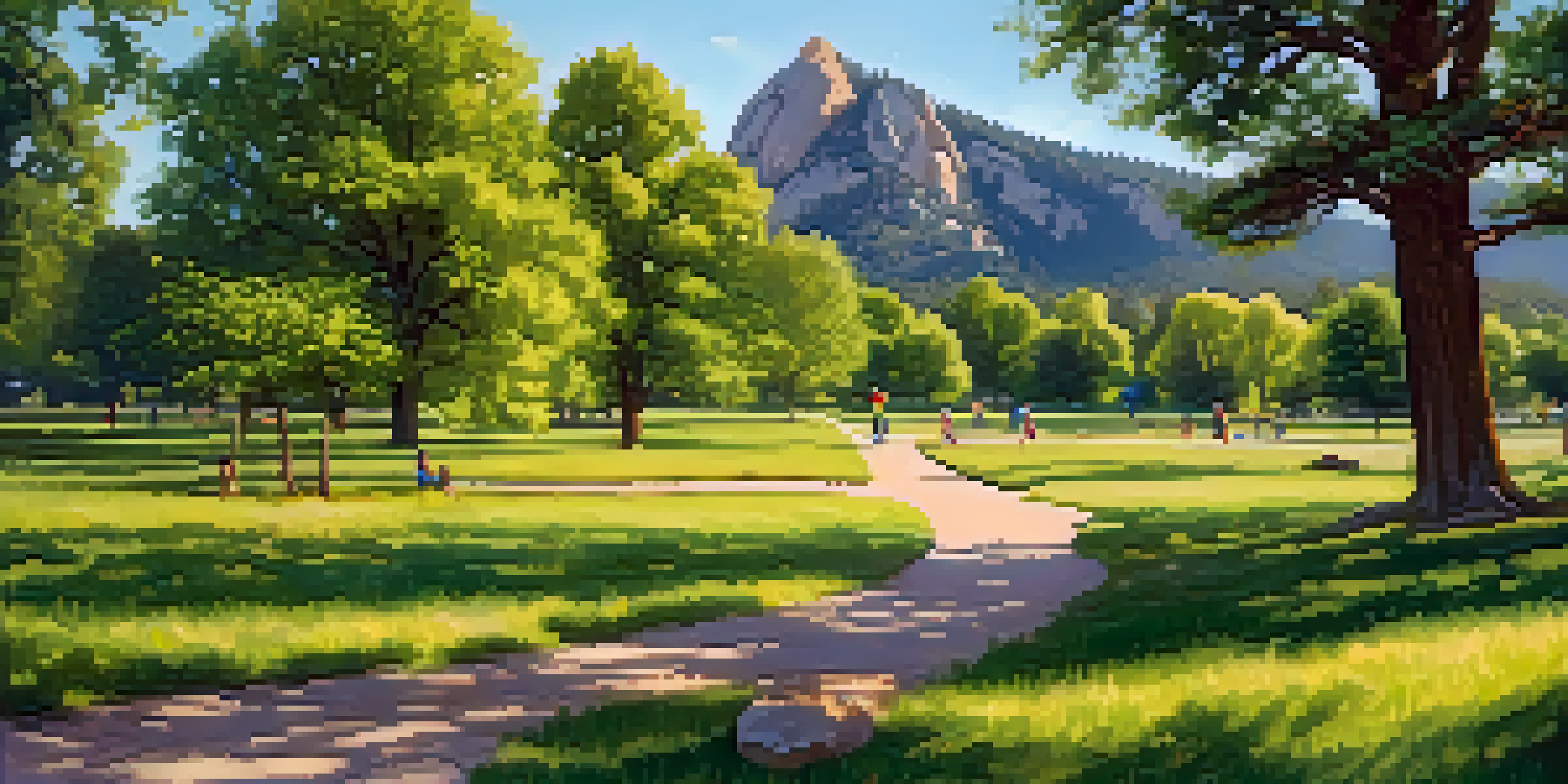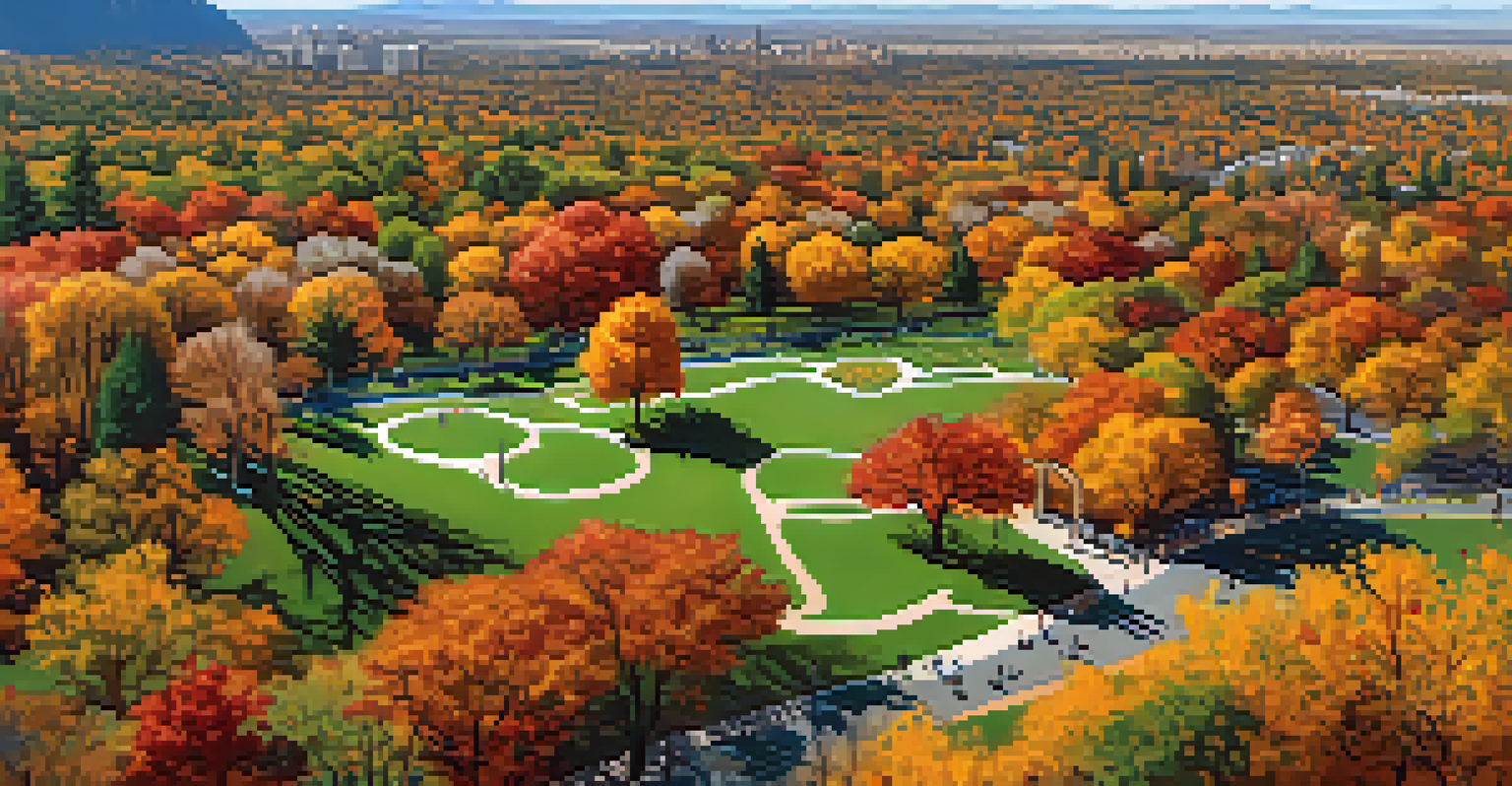Green Spaces in Boulder: Enhancing Urban Living Quality

The Importance of Green Spaces in Urban Areas
Green spaces are vital for urban environments, offering residents a retreat from the hustle and bustle of city life. They not only provide aesthetic beauty but also serve as essential areas for recreation and community gatherings. In Boulder, these spaces contribute significantly to the overall quality of life, promoting physical and mental health.
In every walk with nature one receives far more than he seeks.
Research shows that access to parks and green areas can reduce stress, enhance mood, and encourage physical activity. For instance, spending time in nature has been linked to lower levels of anxiety and depression. When people engage in outdoor activities like walking, jogging, or simply relaxing, they tend to experience a boost in their overall well-being.
Moreover, green spaces play a crucial role in fostering community connections. Parks often become social hubs where neighbors meet, children play, and events take place, strengthening the sense of belonging and community spirit. In Boulder, this is particularly evident in the vibrant local events hosted in parks, drawing residents together.
Boulder's Iconic Parks and Recreational Areas
Boulder is home to a variety of parks that showcase the beauty of the surrounding landscape. From the sprawling Central Park, which serves as a focal point for community events, to the serene Chautauqua Park, known for its stunning views of the Flatirons, each area offers unique experiences. These parks are designed not just for beauty, but for functional use, providing spaces for sports, picnics, and relaxation.

One standout feature of Boulder's parks is their accessibility. Most parks are within walking distance for residents, encouraging outdoor activities and creating a sense of ownership and pride in the community. The well-maintained trails and facilities make it easy for families to spend quality time outdoors, contributing to a healthier lifestyle.
Green Spaces Enhance Urban Life
Access to parks in Boulder significantly boosts physical and mental health, providing a retreat from city stress.
In addition to traditional parks, Boulder embraces innovative green spaces like the Boulder Creek Path, which runs alongside the creek, providing a scenic route for walkers and cyclists. This integration of nature within urban design exemplifies how Boulder prioritizes green living and sustainable practices.
Environmental Benefits of Urban Green Spaces
Beyond aesthetics and recreation, green spaces in urban areas like Boulder offer significant environmental benefits. They help combat air pollution by absorbing carbon dioxide and releasing oxygen, which is essential for a healthier atmosphere. This is particularly important in cities where pollution levels can be high due to traffic and industrial activities.
The creation of a thousand forests is in one acorn.
Additionally, parks and green areas play a critical role in managing urban heat. They help cool the city by providing shade and releasing moisture into the air, which can lower temperatures significantly during hot summer months. This cooling effect contributes to more comfortable living conditions and can decrease energy consumption in nearby buildings.
Lastly, these green spaces support biodiversity by providing habitats for various species. In Boulder, parks serve as essential refuges for local wildlife, including birds, insects, and small mammals. By maintaining these habitats, Boulder not only enhances its natural beauty but also takes steps toward preserving ecological balance.
Community Engagement Through Green Initiatives
Boulder has embraced community engagement as a cornerstone of its green initiatives. Residents are encouraged to participate in the stewardship of local parks through volunteer programs, which include everything from tree planting to clean-up events. This not only helps maintain the beauty of these spaces but also fosters a sense of responsibility and pride among community members.
Local organizations frequently organize events that connect residents with nature, such as guided hikes, educational workshops, and seasonal festivals. These events often draw participation from diverse groups, making green spaces not just places for recreation but also platforms for learning and community bonding.
Boulder's Parks Foster Community
Local parks serve as social hubs, promoting community engagement and strengthening neighborhood bonds.
By involving residents in decision-making processes regarding park developments and improvements, Boulder ensures that the needs and desires of its community are met. This collaborative approach strengthens community ties and ensures that green spaces reflect the values and aspirations of those who use them.
Promoting Health and Well-Being Through Nature
The relationship between nature and well-being is well-documented, and Boulder’s green spaces are a testament to that connection. Regular access to parks encourages physical activities like walking, jogging, or cycling, which are essential for maintaining a healthy lifestyle. Moreover, the tranquility of nature can provide a perfect antidote to the stresses of urban living.
Many residents have shared personal stories of how their local parks have positively impacted their lives. Whether it’s a family bonding over a picnic at a park or an individual finding solace during a morning jog, these spaces serve as essential elements of mental and physical health. The simple act of being outdoors can elevate mood and inspire creativity.
Boulder's commitment to preserving and enhancing its green spaces reflects a broader understanding of health that includes mental wellness. By prioritizing access to nature, the city promotes a holistic approach to health that benefits all residents, reinforcing the idea that a healthy city is one that values its green environments.
Sustainability Practices in Boulder's Green Spaces
Sustainability is at the heart of Boulder’s approach to maintaining its green spaces. The city employs eco-friendly practices such as xeriscaping, which uses drought-resistant plants to conserve water. This not only creates beautiful landscapes but also ensures that the parks remain sustainable in the face of climate challenges.
Additionally, Boulder has implemented innovative waste management strategies in its parks, including recycling and composting programs. These initiatives minimize waste and promote a culture of sustainability among park visitors, encouraging them to think critically about their environmental footprint.
Sustainability in Park Management
Boulder employs eco-friendly practices in its green spaces, ensuring they remain vibrant and beneficial for future generations.
By incorporating sustainable design principles into park planning, Boulder sets an example for other urban areas. This commitment to sustainability not only enhances the beauty of the city's green spaces but also ensures they remain viable and beneficial for future generations.
Future of Green Spaces in Boulder
As Boulder continues to grow, the future of its green spaces is a topic of great importance. City planners and community members are actively discussing how to expand and enhance these areas to meet the needs of a changing population. This includes the potential creation of new parks and the revitalization of existing ones to ensure they remain vibrant and useful.
Innovations in park design, such as the incorporation of technology and smart solutions, are also on the horizon. These advancements can improve the visitor experience, enhance safety, and facilitate better maintenance of the green spaces. Imagine parks equipped with solar lights, interactive maps, or apps that provide information about local flora and fauna.

Ultimately, the goal is to ensure that Boulder’s green spaces continue to enrich urban living. By listening to community feedback and adapting to future needs, Boulder aims to maintain its reputation as a city that values and prioritizes the integration of nature into everyday life.